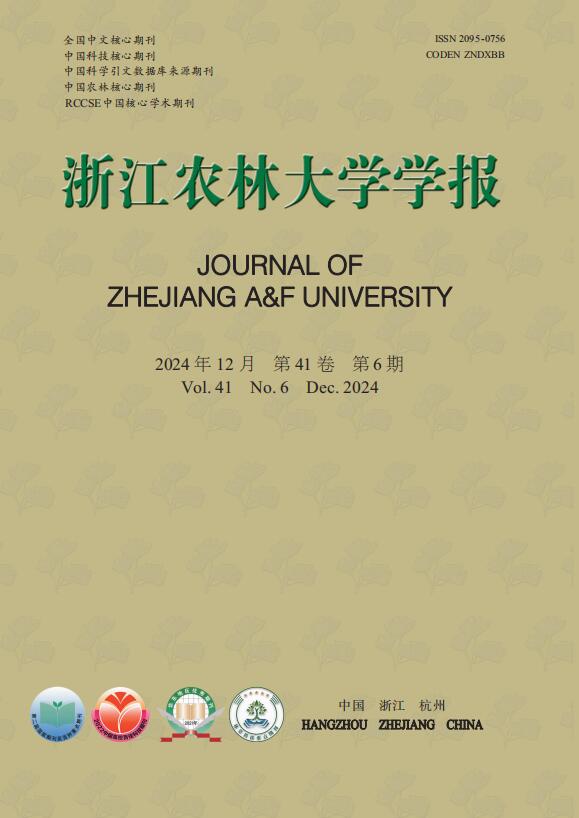-
油茶广义上是山茶科Theaceae山茶属Camellia中种子油脂含量较高的一类植物,是世界四大木本油料树种之一。其中,普通油茶Camellia oleifera是栽培面积最大、最重要的物种。科学经营油茶有保持水土、涵养水源、增加碳汇和调节气候等生态效益,具有重要的生态价值;同时茶油中不饱和脂肪酸高达90%以上,被誉为“油中软黄金”,具有很高的营养和经济价值[1],因此油茶产业是中国山区林农脱贫致富的重要产业。良种是油茶产业健康发展的基础和关键。提高果实产量,发掘高含油率的种质是选育油茶高产良种的重要途径之一。前人对普通油茶的选育大多以果实产量为主要育种目标,种仁含油率的分析和评估还处于起步阶段[2]。研究普通油茶种仁含油率等经济性状的遗传变异规律,可为油茶高含油率种质创制与筛选提供科学依据,对油茶高产良种选育具有重要意义[3]。
杂交育种是林木育种的有效技术之一,通过杂交创造新的变异,可有效缩短育种周期[4]。杂交育种策略在桉树Eucalyptus robusta[5]、杨树Populus spp.[6]、马尾松Pinus massniana[7]、杉木Cunninghamia lanceolata[8]和马褂木Liriodendron sino-americanum[9]等用材树种良种选育中发挥了重要作用,同时培育了大量良种。亲本的科学选配是杂交育种成功的先决条件[10],对杂交亲本进行配合力等遗传参数估算,筛选优良的亲本和亲本组合,能够有效提高杂交育种效率[11]。配合力是指亲本对子代性状的影响力,包括一般配合力和特殊配合力[12]。一般配合力反映亲本的育种利用价值并能预测后代的表现[13],特殊配合力是某一特定组合后代偏离双亲一般配合力的表型偏差[14]。高配合力亲本能够更好地遗传优势性状,在一定程度上预测杂交子代表型,缩小筛选育种材料范围,节省育种时间,提高育种效率[15]。目前,普通油茶的杂交育种工作主要局限于简单互补性状的亲本杂交,关于亲本配合力、重要性状遗传力等遗传参数的研究还处于起步阶段[16]。林萍等[17]对普通油茶杂交子代幼林生长、含油率等性状进行了亲本的配合力分析,初步筛选了一批具有育种潜力的杂交亲本与组合。但由于林木大多数性状的亲本配合力、遗传力等遗传参数会随着树龄的增长而变化。以幼龄林为研究对象对杂交育种的指导具有局限性,因此,以普通油茶杂交子代成林评估各性状的遗传参数显得非常重要。
种仁含油率是油茶高产育种的最主要指标之一。木质素、纤维素、半纤维素等在植物的生长发育过程中具有重要作用,主要表现在增强植物体的机械强度、疏导水分和营养物质的运输、阻止病原菌的侵染以及增强对各种胁迫的防御能力等[18]。MIAO等[19]研究发现:油菜Brassica napus种皮中木质素、纤维素和半纤维素质量分数与含油率呈显著负相关。王安妮等[20]研究也发现:油茶种仁含油率与木质素、纤维素质量分数亦具有显著相关性。因此,研究木质素、纤维素和半纤维素质量分数的遗传规律,对油茶高产育种具有一定的指导意义。
本研究以普通油茶全双列杂交的20个杂交组合为对象,分析了林龄为8 a的盛产期子代群体种仁含油率、木质素、纤维素和半纤维素质量分数的变异规律,探讨了各性状间的相关关系,评估了亲本在4个性状的配合力效应,解析了4个性状在油茶成林阶段的遗传力和杂种优势,为制定油茶高产杂交育种策略提供理论依据。
-
在浙江省金华市婺城区东方红林场国家油茶种质资源收集库内,选择普通油茶无性系‘长林4号’ ‘长林10号’‘长林40号’‘长林53号’‘长林95号’(表1),按照5×5全双列杂交设计创制了20个杂交组合(无自交)。于2014年春季利用杂交子代2年生幼苗营建子代测定林。控制授粉、群体的创制与子代测定林营造管理等参照林萍等[17]的方法。
亲本 含油率/
(mg·g−1)木质素质
量分数/
(mg·g−1)纤维素质
量分数/
(mg·g−1)半纤维素质
量分数/
(mg·g−1)‘长林4号’ 425.32 109.06 84.73 42.65 ‘长林10号’ 402.81 105.87 75.48 49.02 ‘长林40号’ 421.91 98.70 77.87 46.87 ‘长林53号’ 412.38 109.38 77.73 40.82 ‘长林95号’ 400.05 108.78 85.14 35.31 Table 1. Mean value of oil content related traits of parent seed kernel
-
于2021年秋季采集林龄为8 a的子代测定林果实样品测定相关性状。各杂交组合10株一小区,3次重复,共30株单株取样。每单株随机取30颗果实,测定种仁含油率、木质素、纤维素和半纤维素质量分数等性状平均值作为单株果实经济性状。种仁含油率测定采用姚小华等[21]和杨雨晨等[22]的方法。木质素、纤维素和半纤维素质量分数的测定采用王安妮等[20]的方法。
-
用Excel 2010整理数据。性状间采用Pearson相关性分析,家系间的表型差异进行单因素方差分析。利用固定模型估算杂交亲本的一般配合力、特殊配合力和反交效应[23−24],根据随机模型估算加性、显性、表型和遗传方差以及广义、狭义遗传力。估算参照林萍等[17]的方法。所有分析采用DPS软件[25]完成。
-
相关性分析(表2)发现:杂交群体中,普通油茶种仁中的含油率与木质素、纤维素、半纤维素质量分数呈显著(P<0.05)或者极显著负相关(P<0.01)。木质素与纤维素、半纤维素质量分数呈极显著正相关(P<0.01)。纤维素和半纤维素质量分数呈极显著负相关(P<0.01)。因此,在高产油茶良种选育中,除了含油率,木质素、纤维素和半纤维素质量分数也可作为高产种质筛选的重要判断依据。
性状 含油率 木质素
质量分数纤维素
质量分数半纤维素
质量分数含油率 1 木质素质量分数 −0.47** 1 纤维素质量分数 −0.11* 0.19** 1 半纤维素质量分数 −0.30** 0.22** −0.25** 1 说明:*表示显著相关(P<0.05);**表示极显著相关(P<0.01)。 Table 2. Correlation of the kernel traits of the first-filial progency of C. oleifera
-
20个家系的含油率平均值为411.84 mg·g−1,变异幅度为14.46%~53.71%;木质素、纤维素、半纤维素质量分数的平均值依次为106.36、80.19和42.93 mg·g−1,变异幅度分别为4.68%~22.02%、3.70%~13.00%和0.08%~11.89%,其中,半纤维素质量分数的变异系数最大,达38.03%。方差分析结果(表3)表明:含油率和木质素、纤维素、半纤维素质量分数在不同组合间的差异均达到极显著水平(P<0.01),表明采用不同优良性状的无性系开展杂交可为油茶育种创造出变异丰富的育种群体。
性状 自由度 F 平均值/
(mg·g−1)变异
幅度/%变异
系数/%含油率 19 4.61** 411.84 14.46~53.71 13.22 木质素质量分数 19 6.54** 106.36 4.68~22.02 16.82 纤维素质量分数 19 7.06** 80.19 3.70~13.00 16.23 半纤维素质量分数 19 5.27** 42.93 0.08~11.89 38.03 说明:**表示极显著相关(P<0.01)。 Table 3. Variance analysis of the kernel traits of the first-filial progeny of C. oleifera
多重比较结果(表4)表明:含油率最高的前2个家系为‘长林4号’ב长林40号’和‘长林4号’ב长林53号’,其含油率均值为451.58和443.71 mg·g−1,分别是含油率最小家系‘长林40号’ב长林10号’的1.18和1.16倍。‘长林4号’ב长林95号’和‘长林40号’ב长林95号’的木质素和纤维素质量分数在所有的家系中分别是最高和最低的,前者分别是后者的1.39和1.32倍。半纤维素质量分数均值最高的家系为‘长林40号’ב长林10号’,是最低家系‘长林95号’ב长林40号’的1.86倍。家系‘长林40号’ב长林10号’半纤维素质量分数排名第1位,但含油率在所有家系中最低,这与含油率和半纤维素质量分数呈显著负相关关系一致。
组合
(母本×父本)含油率/
(mg·g−1)木质素质量分数/
(mg·g−1)纤维素质量分数/
(mg·g−1)半纤维素质量分数/
(mg·g−1)‘长林4号’ב长林40号’ 451.58±44.39 a 95.08±20.05 fgh 79.89±14.75 bcdef 37.18±17.58 def ‘长林4号’ב长林53号’ 443.71±51.98 ab 109.13±15.61 bcdef 81.50±17.41 abcde 50.47±28.34 abc ‘长林53号’ב长林4号’ 443.37±30.62 ab 107.01±17.97 bcdef 76.47±13.62 cdef 43.49±20.44 bcdef ‘长林40号’ב长林95号’ 435.78±63.22 abc 89.47±13.94 h 69.54±15.58 f 42.08±19.71 bcdef ‘长林10号’ב长林4号’ 424.45±55.25 abcde 108.06±20.22 bcdef 72.66±14.60 ef 46.04±20.28 bcde ‘长林40号’ב长林4号’ 420..91±56.76 abcdef 107.72±15.00 bcdef 76.74±16.14 cdef 37.94±12.10 cdef ‘长林95号’ב长林40号’ 419.66±59.79 abcdef 111.95±24.13 abcde 85.03±13.79 abc 32.03±15.26 ef ‘长林53号’ב长林40号’ 416.62±44.69 abcdef 98.72±13.67 defgh 77.14±11.50 cdef 34.09±18.79 ef ‘长林40号’ב长林53号’ 412..07±50.31 bcdef 97.63±19.16 efgh 74.13±15.27 def 47.78±18.34 abcd ‘长林95号’ב长林53号’ 411.12±45.76 bcdef 106.66±24.80 bcdefg 78.83±13.87 bcdef 37.15±16.84 def ‘长林10号’ב长林95号’ 410.69±28.82 bcdef 109.58±4.43b cdef 70.68±6.51 ef 52.95±15.12 ab ‘长林4号’ב长林10号’ 408.77±19.15 bcdef 107.98±7.25 bcdef 86.05±5.39 ab 44.08±6.72 bcdef ‘长林95号’ב长林4号’ 403.41±80.21 cdef 101.71±13.46 cdefgh 87.75±14.86 ab 36.32±13.56 def ‘长林4号’ב长林95号’ 397.24±38.43 def 124.07±14.67 a 91.48±5.42 a 38.87±11.49 cdef ‘长林53号’ב长林10号’ 395.50±57.45 ef 111.34±37.01 abcde 83.36±13.95 abcd 40.06±16.08 bcdef ‘长林53号’ב长林95号’ 394.00±65.17 ef 120.46±24.40 ab 73.96±11.38 def 45.63±16.09 bcde ‘长林10号’ב长林53号’ 391.03±45.67 ef 113.45±20.75 abcd 79.91±13.28 bcdef 50.08±15.41 abc ‘长林95号’ב长林10号’ 388.98±48.55 ef 114.81±17.24 abc 88.96±15.89 ab 35.74±10.70 def ‘长林10号’ב长林40号’ 385.08±40.73 ef 92.39±15.12 gh 78.66±9.01 bcdef 47.02±13.68 bcde ‘长林40号’ב长林10号’ 382.87±65.80 f 99.97±20.04 cdefgh 91.08±20.64 a 59.66±20.08 a 说明:数据为平均值±标准差。同列不同小写字母表示差异极显著(P<0.01)。 Table 4. Multiple comparison results of kernel traits in first-filial progeny of C. oleifera
-
本研究中不同组合间各性状均差异极显著(P<0.01)。在此基础上,进一步采用固定模型评估杂交亲本的配合力。由表5可知:杂交亲本在纤维素和半纤维素质量分数的一般配合力、特殊配合力和反交效应值差异均达极显著水平(P<0.01)。亲本含油率的一般配合力和特殊配合力差异达极显著水平(P<0.01),反交效应值无显著差异。木质素质量分数的亲本一般配合力和反交效应值差异达极显著水(P<0.01),特殊配合力差异不显著。可见,普通油茶杂交育种中,一般配合力、特殊配合力和反交效应值对杂交群体含油率和木质素、纤维素和半纤维素质量分数等性状具有极显著影响(P<0.01)。
变异来源 自由度 F 含油率 木质素
质量分数纤维素质
量分数半纤维素
质量分数一般配合力 4 11.18** 15.57** 3.98** 7.26** 特殊配合力 5 6.45** 0.88 7.32** 3.88** 反交效应值 10 1.31 6.08** 8.10** 5.03** 说明:**表示差异极显著(P<0.01)。 Table 5. Variance analysis of combining ability and reciprocal cross effect in complete diallel cross of C. oleifera
对差异极显著的各亲本一般配合力多重比较(表6)表明:‘长林4号’含油率和纤维素质量分数的一般配合力均最高,分别为1.64和0.18,这与该良种年平均产油量高的特性一致。在半纤维素质量分数中,‘长林10号’的一般配合力最高,为0.54,明显高于其他亲本,同时‘长林10号’的含油率一般配合力最低,为−1.79。‘长林95号’木质素质量分数的一般配合力排名第1位,为0.46,含油率的一般配合力为−0.56,排名倒数第2位。可见,在高含油率杂交种质创制时,除了选择含油率一般配合力高的亲本外,选择木质素、纤维素和半纤维素质量分数一般配合力较低的亲本也是可行的。
亲本 一般配合力估计值 含油率 木质素
质量分数纤维素
质量分数半纤维素
质量分数‘长林4号’ 1.64 0.16 0.18 −0.15 ‘长林10号’ −1.79 0.11 0.16 0.54 ‘长林40号’ 0.50 −0.97 −0.16 −0.09 ‘长林53号’ 0.21 0.23 −0.27 0.09 ‘长林95号’ −0.56 0.46 0.08 −0.38 说明:表中数据均为平均值。 Table 6. Estimated general combining ability of female parent of each cross
不同杂交组合含油率的特殊配合力为−2.23~1.66,根据含油率的特殊配合力效应选出前5个亲本组合为‘长林40号’ב长林95号’(‘长林95号’ב长林40号’)、‘长林4号’ב长林53号’(‘长林53号×长林4号’)、‘长林10号’ב长林95号’(‘长林95号’ב长林10号’)、‘长林4号’ב长林10号’(‘长林10号’ב长林4号’)和‘长林4号’ב长林40号’(‘长林40号’ב长林4号’)(表7)。由于木质素、纤维素、半纤维素质量分数与含油率呈负相关,因此在以含油率为育种目标时,宜选择特殊配合力较低的组合。各杂交组合木质素含量的特殊配合力为−0.22~0.31,由于组合间差异不显著(表5),因此该特殊配合力效应只作为筛选优良组合的参考,不具有决定性。根据纤维素和半纤维素质量分数的特殊配合力,筛选出纤维素质量分数特殊配合力较低的组合有‘长林4号’ב长林10号’(‘长林10号’ב长林4号’)、‘长林10号’ב长林95号’(‘长林95号’ב长林10号’)、‘长林4号’ב长林40号’(‘长林40号’ב长林4号’)、‘长林40号’ב长林95号’(‘长林95号’ב长林40号’)和‘长林53号’ב长林95号’(‘长林95号’ב长林53号’)。筛选出半纤维素质量分数特殊配合力较低的组合有‘长林40号’ב长林95号’(‘长林95号’ב长林40号’)、‘长林4号’ב长林40号’(‘长林40号’ב长林4号’)、‘长林40号’ב长林53号’(‘长林53号’ב长林40号’)、‘长林4号’ב长林10号’(‘长林10号’ב长林4号’)、‘长林10号’ב长林53号’(‘长林53号’ב长林10号’)。
序号 组合
(母本×父本)含油率 木质素质量分数 纤维素质量分数 半纤维素质量分数 特殊配合力 反交效应值 特殊配合力 反交效应值 特殊配合力 反交效应值 特殊配合力 反交效应值 1 ‘长林4号’ב长林53号’ 1.31 0.02 −0.22 0.11 −0.03 0.25 0.47 0.35 ‘长林53号’ב长林4号’ 2 ‘长林4号’ב长林95号’ −2.23 −0.31 0.02 0.03 0.68 0.19 −0.01 0.13 ‘长林95号’ב长林4号’ 3 ‘长林53号’ב长林95号’ −0.57 −0.86 0.03 0.69 −0.18 −0.24 0.14 0.42 ‘长林95号’ב长林53号’ 4 ‘长林4号’ב长林40号’ 0.30 1.53 0.31 −0.63 −0.22 0.16 −0.29 −0.04 ‘长林40号’ב长林4号’ 5 ‘长林40号’ב长林53号’ −0.46 −0.23 −0.08 −0.05 −0.03 −0.15 −0.19 0.68 ‘长林53号’ב长林40号’ 6 ‘长林40号’ב长林95号’ 1.66 0.81 −0.06 −1.12 −0.21 −0.77 −0.11 0.50 ‘长林95号’ב长林40号’ 7 ‘长林4号’ב长林10号’ 0.62 −0.78 −0.11 0.27 −0.43 0.67 −0.17 −0.10 ‘长林10号’ב长林4号’ 8 ‘长林10号’ב长林53号’ −0.28 −0.22 0.27 0.11 0.25 −0.17 −0.41 0.50 ‘长林53号’ב长林10号’ 9 ‘长林10号’ב长林95号’ 1.15 1.08 0.01 −0.26 −0.28 −0.91 −0.02 0.86 ‘长林95号’ב长林10号’ 10 ‘长林10号’ב长林40号’ −1.50 0.11 −0.16 −0.38 0.46 −0.62 0.60 −0.63 ‘长林40号’ב长林10号’ Table 7. Values of specific combining ability and reciprocal cross effect for different combinations of C. oleifera
依据反交效应。可判断一对杂交亲本中哪个做母本更易获得性状优良的杂交子代。通常,反交效应值为正时,正交组合能够更容易获得较高水平表型的子代,反交效应值为负时,采用反交组合将更易创制较高水平表型的子代。对依据特殊配合力筛选出的5个亲本组合,进一步根据反交效应确定高含油率的杂交组合为‘长林40号’ב长林95号’、‘长林4号’ב长林53号’、‘长林10号’ב长林95号’、‘长林10号’ב长林4号’和‘长林4号’ב长林40号’。低纤维素特殊配合力的杂交组合为‘长林10号’ב长林4号’、‘长林10号’ב长林95号’、‘长林40号’ב长林4号’、‘长林40号’ב长林95号’和‘长林53号’ב长林95号’。低半纤维素的杂交组合有‘长林53号’ב长林10号’、‘长林4号’ב长林40号’、‘长林53号’ב长林40号’、‘长林4号’ב长林10号’和‘长林95号’ב长林40号’。综合子代含油率、纤维素、半纤维素质量分数的配合力分析结果,筛选出‘长林40号’ב长林95号’和‘长林4号’ב长林53号’,这2个组合含油率的特殊配合力较高,含油率在20个家系中的排名分别为第4位和第5位,在纤维素质量分数排名为第20位和第8位;在半纤维素质量分数排名为第11位和第3位。推测这2个组合在普通油茶高含油率育种中具有重要的育种潜力和价值。
-
在本研究群体中,含油率和纤维素和半纤维素质量分数的显性方差均大于加性方差(表8)。其中,含油率的加性方差和显性方差分别为1.38、2.39,显性方差是加性方差的1.73倍;纤维素质量分数的遗传方差主要为显性方差,加性方差为0;半纤维素质量分数的显性方差略大于加性方差,是加性方差的1.24倍。可见这3个性状均以非加性遗传效应控制为主,加性效应次之,尤其是纤维素质量分数主要由显性遗传效应控制。木质素质量分数的加性方差为0.58,显性方差为0,这一性状主要由加性效应控制,这与木质素质量分数的特殊配合力方差差异不显著是一致的。含油率和木质素、纤维素和半纤维素质量分数的广义遗传力为7.86%~14.03%,狭义遗传力为0~14.03%,遗传力均较低,说明这些数量性状受到较强的环境效应影响。
遗传参数 加性
方差显性
方差遗传
方差表型
方差广义遗
传力/%狭义遗
传力/%含油率 1.38 2.39 3.74 30.00 12.55 4.60 木质素质量分数 0.58 0.00 0.58 4.17 14.03 14.03 纤维素质量分数 0.00 0.20 0.20 2.05 9.52 0.00 半纤维素质量分数 0.11 0.14 0.25 3.16 7.86 3.51 Table 8. Major genetic parameters for kernel traits of C. oleifera
-
在本研究中,含油率与木质素、纤维素和半纤维质量分数在油茶群体中具有显著负相关关系。MIAO等[19]研究发现:油菜籽含油率与木质素和纤维素质量分数也存在显著负相关,且相关性系数与油茶相当;与半纤维素质量分数的相关性系数略低。WANG等[26]研究表明:油菜籽中的纤维组分包括木质素、纤维素和半纤维素,对含油率有负面影响。推测可能是纤维素和半纤维素的合成减少了进入种子油生物合成途径中的光合同化物,从而导致含油率降低[27−28]。SCHILBERT等[29]研究发现:BnaPAL4基因在这个过程中起重要作用。可见,木质素、纤维素、半纤维素质量分数等3个性状作为间接参考指标,衡量油茶种仁含油率是可行的。当油脂测定不便或样本材料较少时,可通过测定饼粕中木质素、纤维素和半纤维素质量分数间接评估油茶中的含油率。
-
目前,油茶产业上用的无性系良种多来源于选择育种,但通过选择育种来培育高产优质新品种的潜力逐渐减小。正确选择亲本是普通油茶杂交育种成功的基础和关键,开展杂交亲本一般配合力和特殊配合力的估算,能够更高效地提高育种效率。本研究发现:普通油茶杂交亲本在油脂性状上的一般配合力、特殊配合力和反交效应都差异极显著,表明亲本评估对以含油率为育种目标的普通油茶杂交非常关键。
本研究中,5个亲本在含油率以及木质素、纤维素和半纤维素质量分数等4个性状中的一般配合力有较大差异。同一亲本的一般配合力在不同的性状间存在明显差异,同一性状在不同亲本的一般配合力间也存在显著差异。如‘长林4号’在含油率的一般配合力最高,在半纤维素质量分数的一般配合力是倒数第2位。亲本在半纤维素质量分数的一般配合力范围较大,最高的‘长林10号’一般配合力为0.54,最低的‘长林95号’一般配合力为−0.38,这与桤木Alnus cremastogyne种间杂交亲本种实性状(种子长度、宽度、千粒重)的配合力情况相同[30]。同样地,各组合在4个油脂相关性状上的特殊配合力值也存在显著差异。
-
一般配合力和特殊配合力的相对重要性一直是林木杂交育种中亲本的评估重点[17]。研究表明:一般配合力和特殊配合力的相对重要性受测试材料、性状、地点和树龄等的影响[15]。牛慧敏等[31]研究发现:对于杉木幼林的干形性状,一般配合力测定比特殊配合力测定更重要。吴兵等[32]研究发现:桉树种间杂交子代的生长性状受加性与非加性效应的共同作用,但是以加性效应为主,所以应更关注双亲的一般配合力。林萍等[15]针对油茶5×5全双列杂交子代幼林生长性状的研究表明:一般配合力比特殊配合力更重要;对(不完全双列杂交)设计的油茶子代林分析发现:林龄不同其生长性状的一般配合力和特殊配合力方差分量也不相同,1年生子代林的一般配合力方差分量高于特殊配合力,而2年生子代林一般配合力方差分量均明显低于特殊配合力[16]。柴静瑜等[33]对进入盛产期的油茶巢式杂交子代群体进行遗传分析显示:组合间含油率和脂肪酸质量分数的差异主要来源于双亲的特殊配合力,评估双亲的特殊配合力远比亲本的一般配合力更重要。赵颖等[14]评估了马尾松纸浆材主要经济性状,发现特殊配合力相对重要性大于一般配合力。在本研究中,油茶杂交子代成林的含油率和纤维素质量分数的显性方差显著大于加性方差,这2个性状亲本的特殊配合力比一般配合力更重要。半纤维素质量分数的显性方差与加性方差相当,说明半纤维素质量分数亲本的一般配合力和特殊配合力同等重要。因此,在以含油率为育种目标的油茶杂交中,优先选择特殊配合力较高的亲本组合,同时兼顾亲本的一般配合力。
-
因受测试材料、性状、地点和树龄等因素的不同,遗传力也有差别。吴兵等[32]研究发现:桉树幼林各生长性状遗传力均在0.57以上。黄逢龙等[34]发现:杨树无性系的各树冠性状遗传力都较低,均小于0.50。在马尾松巢式交配子代生长性状遗传分析发现:胸径、树高和单株材的广义遗传力为0.48~0.69,受中度遗传控制[7],这与红松Pinus koraiensis[35]的研究结果一致。林萍等[17]研究发现:普通油茶杂交子代林幼龄时期种仁含油率、脂肪酸成分及其质量分数等经济性状受环境影响较大,遗传控制力度较弱。柴静瑜等[33]研究发现:盛产期后油茶油脂性状的遗传力显著升高,尤其是硬脂酸、油酸、亚油酸等决定油脂品质的脂肪酸质量分数。可见,子代幼林的遗传力评估仅可作为油茶杂交育种策略制定的参考,重点应关注成林的遗传力参数。
-
本研究发现:普通油茶含油率和木质素、纤维素、半纤维素质量分数4个性状在组合间存在显著差异,且含油率与木质素、纤维素、半纤维素质量分数间存在显著负相关;4个性状的亲本一般配合力、特殊配合力和反交效应值差异显著。含油率和纤维素质量分数的遗传方差以显性效应为主,半纤维素质量分数的加性方差与显性方差相当,而木质素质量分数的遗传方差则以加性效应为主;4个性状的遗传力均较低,受环境影响较大。在此基础上,筛选出可用于高含油率种质创制的优良亲本‘长林4号’和‘长林40号’,优良杂交组合‘长林40号’ב长林95号’和‘长林4号’ב长林53号’。
Genetic analysis of kernel oil content and related traits in complete diallel progenies of Camellia oleifera
doi: 10.11833/j.issn.2095-0756.20230603
- Received Date: 2023-12-15
- Accepted Date: 2024-09-18
- Rev Recd Date: 2024-06-06
- Available Online: 2024-11-20
- Publish Date: 2024-11-20
-
Key words:
- Camellia oleifera /
- complete diallel cross /
- oil-related traits /
- genetic analysis
Abstract:
| Citation: | WANG Anni, WANG Kailiang, CHAI Jingyu, et al. Genetic analysis of kernel oil content and related traits in complete diallel progenies of Camellia oleifera[J]. Journal of Zhejiang A&F University, 2024, 41(6): 1170-1179. DOI: 10.11833/j.issn.2095-0756.20230603 |









 DownLoad:
DownLoad: